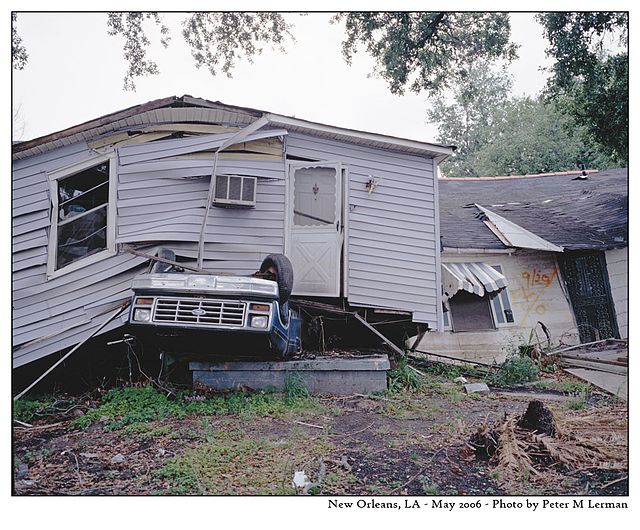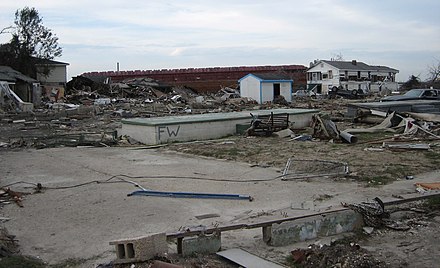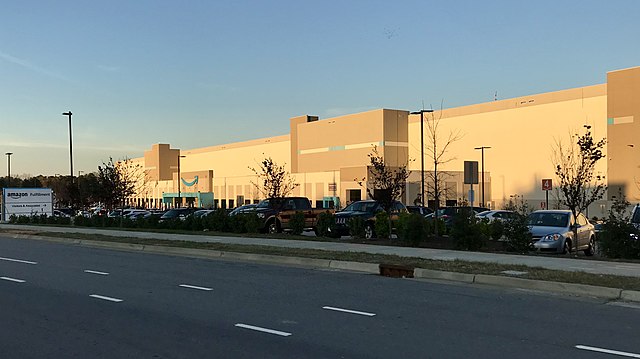The Problem
On August 29th, 2005, around ten in the morning, the levee wall protecting The Lower Ninth Ward broke in multiple sections with 80% of New Orleans was flooded, and some parts under 15 feet of water. Hurricane Katrina tore through the coastal areas of the Gulf Coast states, and in August of 2005 Mississippi Governor, Haley Barbour stated “I can only imagine that this is what Hiroshima looked like 60 years ago.” It was like something out of a nightmare. And the worst part? People were stranded on rooftops, without food or water, for days.
Melanie Potts, a resident of New Orleans during Katrina said that “The sadness was overwhelming. I didn’t know if it would ever return to be the same New Orleans home I left months before.” Patricia Jones, president of the Lower Ninth Ward Neighborhood Empowerment Network Association, stated that “we [Lower Ninth Ward], were the last to get [federally funded] trailers, and the city tore down a lot of houses here they were not supposed to. Around 1,800 deaths occurred, $100 billion in property damage was done, and New Orleans was swallowed up by the storm. Half a year after the catastrophe, the Lower Ninth Ward was the last neighborhood in the city still subject to a curfew. In addition, it was the last place to have its water and power restored, as well as the last to be pumped dry.

House on top of a car in the Lower 9th Ward post Katrina (Photo by Matt Butts)
Some parts of the lower ninth ward neighborhood were under ten feet of water due to the flooding, and many people were forced to stay in their homes or run to the roofs to avoid drowning. Calvin Alexander, a resident of the Lower Ninth Ward, stated that “much of the Lower Ninth Ward was flooded to an extent that people could not even come home. There are people, quite frankly, who are still coming home.” Chris Edwards, a chairman at the CATO institute, stated that the government response was hindered by a lack of preparation and coordination among different agencies. In addition, during a radio interview with WWL-AM, former New Orleans mayor Ray Nagin famously criticized the federal government’s response to Hurricane Katrina in strong terms. Nagin expressed his disappointment with the Bush administration and used profanity while urging the federal government to provide additional assistance to the city. Long-term warnings were ignored, specifically referring to the levees. Federal officials have stated that Louisiana and New Orleans authorities were in charge of the initial evacuation and hurricane preparation plans, and they blame those officials for not approaching the federal government for assistance quickly enough and without being sufficiently precise.

Ruins of the residential area of the Lower 9th Ward, with a barge that went over the levee in background.
Habitat of Humanity launched Operation Home Delivery, in September of 2005, The “House in a Box” project. Essentially, portable houses that came in boxes and were ready to be assembled. The Road Home Program was started in Louisiana in June of 2006. The program was created to aid homeowners whose homes had been damaged or destroyed by the hurricane by providing them with money to help them fix or rebuild their homes. The Make It Right organization was a non-profit foundation founded by American actor Brad Pitt in December 2007. The foundation was established to help in the environmentally friendly rebuilding of homes in New Orleans and specifically the Lower Ninth Ward. By March 2013, Make It Right had completed 90 of the proposed 150 homes. By March 2013, the foundation had finished 90 of the proposed 150 houses. Although efforts were made to help rebuild the Lower Ninth Ward, where was assistance in the rebuilding of supermarkets? Where is the poorest neighborhood in New Orleans supposed to get their food from?
Since 2014, Burnell Cotlon has been running the only grocery store in the Lower Ninth Ward. Almost ten years after Hurricane Katrina, the closest grocery store was the Walmart in Chalmette, which is at least a ten-minute drive from the Lower Ninth Ward. Before Cotlon opened his market, residents had to take three city buses to purchase fresh groceries. Cotlon told The Washington Post that “Life in this neighborhood is an underlying condition: hard jobs, long hours, bad pay, no health insurance, no money, bad diet. That’s every day. They have disabilities. They have high blood pressure, breathing problems, and diabetes. Before I opened, this part of the city was a food desert.” To add to this heartache, Cotlon added, “Imagine if you don’t have a car and you have three or four kids. You have to get on those buses with those kids and then get to Wal-Mart and go up and down those aisles. Now you have to get back on those buses with those kids and bags.”
The COVID-19 pandemic has, similarly to how it has in many other neighborhoods around the country, also contributed to an increase in the level of food insecurity in the Lower Ninth Ward. Burnell Cotlon, the owner of Burnell’s Lower 9th Ward Market, stated, “If I had to compare COVID-19 to Hurricane Katrina, it’s a no-brainer. At least with a hurricane, you can pick your family up and leave because you have a warning. With this virus it’s impossible.” As a result of the fact that the New Orleans area economy lost 99,900 jobs by the end of April 2020 or had their hours cut back by 10%, it is now much more challenging to put food on the table. In addition, the pandemic has made it more challenging for locals to gain access to food assistance programs. This is due to the fact that many of these organizations have been forced to make adjustments to their procedures in order to combat the pandemic. In 2000, poverty levels in the ward were more than double that of the U.S. average. That is still the case in 2023, with the average household income sitting around $33,000.
Poverty and a lack of financial support are to blame for the neighborhood’s unsuccessful attempts at recovery, as well as the food insecurity that the community still struggles with today. In order to rebuild, families need money. And they need money in order to provide nutritious meals for their family. According to the data provided by the United States Department of Agriculture, “persons with lower incomes spend about the same amount of money on food as those with higher incomes.” This indicates that a greater proportion of their total income is being spent on food. Being a resident of a location considered a “food desert” makes it much more difficult to obtain access to healthy, freshly prepared foods. Faye Matthews, the legal policy adviser for the Mississippi River Delta Restoration and Gulf Restoration with the National Wildlife Federation, stated that “you cannot talk about food justice without talking about the larger context, and the larger context is economic insecurity.” “Racial and economic justice are two prerequisites for food justice.” The Lower Ninth Ward is poisoned with many factors typically found in Food Desert Areas, a minority population of over 80%, over 36% of the population living below the poverty line, and a lack of proper food access. The Lower Ninth Ward is in need of saving…
The Solution
When you look up an item, the first item in a google search is a link straight to Amazon. Amazon has acquired over 100 companies, all across different fields. Amazon, the king of online shopping, also owns a large number of companies like Whole Foods, Zappos, IMDb, Washington Post, Twitch, and ShopBop. In total, Bezos owns over 20 companies, including stakes in Google, Airbnb, and Uber. The last name “Bezos” and the word “monopoly” are not used interchangeably. Why was a company that owned 90% of the oil industry in 1882 to be destroyed, yet Bezos’s company is not? Stephanie Chevalier, an E-commerce research and editorial expert, stated that “Amazon’s market share will account for 50 percent of the entire e-commerce retail market’s gross merchandise volume.” Amazon is dominating the online shopping industry worldwide. I mean, Amazon has literally been titled “The Everything Store.” They have crushed the thrill of in-person shopping and robbed real people of real money. Suzanne Brisendine of San Francisco stated that “It [Amazon] is becoming a monopoly, and we as a culture are so bedazzled by billionaires that our legislators seem incapable of creating regulations to curb aspiring monopolies’ worst practices.”
Tim Wu, another average American consumer and small business owner, argued that “New York City’s mom-and-pop stores are on the demise, even though local stores can be cheaper and more efficient than ordering from Amazon.” Isn’t this what the Anti-Trust law was supposed to protect us from? Quoted from yet another American consumer and said perfectly, “we as a culture are so bedazzled by billionaires that our legislators seem incapable of creating regulations to curb aspiring monopolies’ worst practices.”
Amazon has a revenue of 514 billion dollars, owns about 38% of online retail sales in the US, and is expected to gain 50% of the entire online retail world in 2023. Jeff Bezos donates billions to charity, including two billion dollars to the Day 1 Families Fund and $500 million dollars to address homelessness. In addition, he has donated ten billion dollars to the Bezos Earth Fund, fighting climate change. Amazon increasingly and steadily helps the US government. Again, directly from Bezos himself, he states that “By collecting and remitting taxes on behalf of our customers and sellers, we [Amazon] help reduce compliance costs and ensure that state and local governments receive revenues on a timely basis.” They also generated over 500 billion dollars of revenue in 2022, and consumers are obsessed. There are about 332 million people in the US, and 150 million of them are Amazon Prime members. That means more than 70% of Americans use Amazon.
Amazon is responsible for the creation of more than 950,000 full-time and part-time jobs. Furthermore, Amazon has invested such a large sum of money that it has inadvertently contributed to the creation of employment opportunities in the hospitality and construction industries. According to Bezos himself, “Amazon has now invested more than $2.9 billion in Wayne County and, as a result, contributed an additional $2.5 billion to the local economy. ”The construction of warehouses in different parts of the world has helped boost the economy and provide employment opportunities for many people. As of January 2022, Amazon has 1,137 distribution centers and plans to build 331 more. Amazon also has more than 175 fulfillment centers worldwide. This includes more than 200 million square feet of space.
Well, how about giving your space to charity?

Massive Amazon fulfillment center in Garner, North Carolina (Photo by Indy Beetle)
The Implementation
In order to help improve the food desert status of the Lower Ninth Ward and address hunger issues within the community, Jeff Bezos should invest a chunk of his money designated to charity, into a factory-sized supermarket for the Lower Ninth Ward. In 2012, he and his wife, MacKenzie Scott, donated $2.5 million to the Washington-based nonprofit Food Lifeline, which distributes food to local food banks and meal programs in the region. Bezos, in 2020, also donated $100 million to help food banks that were facing shortages due to the covid-19 outbreak. Bezos himself said that “even in ordinary times, food insecurity in American households is an important problem.” There is simply one small market to feed the population of around 27,000 individuals living in The Lower Ninth Ward, and a giant factory-sized discount supermarket is exactly what these people need. We know that Amazon owns more than 175 factories, which add up to a total of more than 200 million square feet. There also happens to be a completely vacant Amazon factory in Knoxville, Tennessee. Both the Alcoa and North Knoxville locations were set to open in 2022 but have yet to start packaging orders as of March 2023. That is money and resources that could be directed elsewhere. But, does Bezos need to develop his own model for this?
Imperfect Foods is a grocery delivery service started in Baltimore, Maryland, by Ben Simon in 2015 that specializes in selling “ugly” or “not aesthetically pleasing” produce and other supermarket items that were deemed good to eat but didn’t necessarily meet the standards of traditional grocery stores. Imperfect Foods aimed to reduce waste and provide conveniences for more affordable grocery shopping. But the best part, in 2018, the company signed a lease for an old 76,000-square-foot factory as the designated delivery hub for groceries in Baltimore. Then, in 2020, the grocery service signed a lease for a 110,000-square-foot factory in Hanover, Maryland. The business offers low-income families and people who are facing food insecurity free grocery deliveries through a program known as “The Grocery Delivery Fund.” In this program, Imperfect Foods collaborates with neighborhood nonprofits and community organizations to select and deliver free groceries to people and families in need. In addition, the business contributes extra food to nearby food banks and pantries, assisting in providing healthy food to people who might not otherwise have access to it.
 NOLAbeings
Multimedia artist Claire Bangser created NOLAbeings as a portrait-based story project that marries...
NOLAbeings
Multimedia artist Claire Bangser created NOLAbeings as a portrait-based story project that marries...
 Data corner: Adobe Suite (create a PDF, social media graphic, presentation, edit a photo and video
Data corner is where you go to work with analytics and top tech skills. It takes on everything from PERL and SQL to Canva and Sprout Social.
Data corner: Adobe Suite (create a PDF, social media graphic, presentation, edit a photo and video
Data corner is where you go to work with analytics and top tech skills. It takes on everything from PERL and SQL to Canva and Sprout Social.
